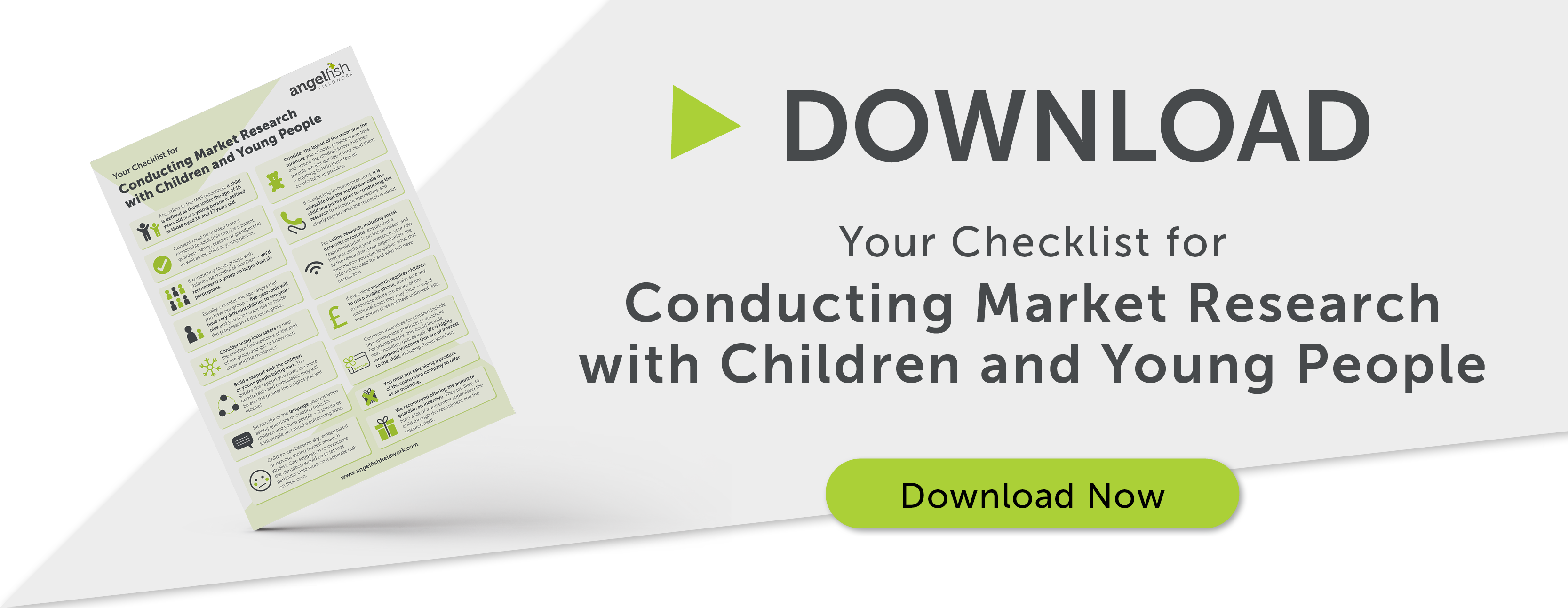
6 Ways to Recruit Children and Young People for Market Research
In recent years there’s been a shift in the market research world with more and more qualitative market research being carried out with children and young people.
We’re now starting to move away from more traditional opinions that children and young people are solely objects of enquiry, towards the view that they have their own unique thoughts and insights that are important in their own right. And quite rightly so – after all, children and young people tend to bring a more fresh and honest perspective than adults, meaning that they don’t just have a right to be involved; they need to be involved in order to improve the quality of research, especially as Gen Z and Gen Alpha are becoming an increasingly important demographic in market research and as a result brands are becoming increasingly keen to reach out to them.
The Market Research Society (MRS) Code of Conduct defines children as those under the age of 16 years and young people as those aged between 16 and 17 years. Whatever the age of the young people taking part, the most important thing to remember is that their welfare should be the number one priority at all times – which means there are a number of practical and ethical issues that must be considered in addition to the usual concerns of market research. So how do you recruit children and young people for qualitative market research? What considerations are there? What’s the best methodology? There’s an awful lot to think about – which is why we’ve put together our top tips for recruiting children and young people here…

Reach out to the gatekeeper
Recruiting children and young people to take part in qualitative market research almost always needs to be done via a ‘gatekeeper’ who is usually a responsible adult such as a parent, teacher, carer or youth worker. It’s important to appeal to and involve gatekeepers during all the stages of market research projects because they will more than likely be the ones who provide the initial consent – so your project needs to get a thumbs up from them, especially if you are recruiting via parents who not only act as a gatekeeper but are also required to give consent for their child to take part, too.
Make sure you get consent
According to the MRS guidelines, children under 16 must not be consulted about market research projects without the consent of a parent, guardian or responsible adult first. One of the reasons why it’s a good idea to ask the parent first is to avoid a situation in which a child has agreed to participate and subsequently finds they aren’t allowed to do so. The young person will then give their own consent – and have the opportunity to decline to take part in the research if they want, as well. You should also be aware that while parental consent is required, they cannot consent on behalf of the child. Even when it comes to market research with very young children, you will still need to gain the informed consent of the child - either by communicating with them in a language they understand or by asking parents to help you do so.
In order to make an informed decision as to whether or not they want to take part, respondents should have a basic checklist to ensure they are fully informed about:
- What the research is asking of them and why
- What the research is trying to find out
- The purpose of the research who is carrying it out
- How the information will be recorded
- What will happen to the data
- Who will see the results
- We would always recommend that you provide this information in writing, it’s worth doing for practical reasons and for the audit trail, too.
Create a family friendly environment
It’s also important to make sure your research takes place in a safe and appropriate location that is non-threatening and comfortable. If you are carrying out one-to-one interviews with older children, home can be a great place as it’s where they feel most comfortable. One reason that it’s so important to carefully consider the location is because it can have a big impact on the responses. For example, if you are using a large boardroom, the size and formality of it might be intimidating and not bring out the results you were hoping for. Likewise, if you’re carrying out research in a school setting, their usual experience in that particular environment might impact their results.
Wherever you decide to carry out your qualitative market research project, the most important thing is to create a relaxed and open atmosphere where participants can be encouraged to share their views. The whole set up should be as ‘homely’ as possible, even down to wearing informal clothes and coming down to the level of the child if you can, rather than sitting across from them at a desk. And creating a family friendly or homely environment to conduct the research isn’t just for the children and young people - it will also help get parents on-board and get them behind the research, too.
Choose the right methodology
Choosing the right type of methodology is really important when it comes to carrying out research with children and young people, with the age of the children involved having a significant impact on the tools you use and the methodology you choose. When dealing with children of secondary school age, for example, you’ve got a lot more choice and can use most of the methods that you would with adults as long as they are adapted to suit the age group. However the younger the children, the more you should steer clear of formal and structured methods and instead keep things fun, brief and to the point.
Other top tips include avoiding using a dry ‘question and answer’ format for the entire session; try and include some more interactive and creative activities and use ice-breaking exercises before launching into data collection as well. Friendship pairs are also a fantastic methodology for children and young people; joining a group of strangers can be daunting for them, so recruiting in friendship pairs is a great solution as having a friend with them may put them at ease, which can ultimately help to create more free flowing discussions so you can generate rich, insightful results.
For more ideas on how to keep young people engaged during research, check out our five top tips for engaging and empowering young people
Choose the right person
Since market research with children and young people requires a specialist approach, you should always try and work with people with the appropriate experience. Your chosen researcher or moderator should be careful to use language that is simple but not patronising, and they must take into account the degree of maturity of the child when considering what subjects may or may not be safely dealt with. For example, while you might have to avoid certain subjects when interviewing children, the same subject might quite safely be covered with young people if the appropriate precautions are taken. As with most research with children, this is a question of good research practice as much as of ethics.
However, it is very important that anyone who is going to carry out interviews with children and young people is carefully screened for their suitability given the growing concern of parents and the general public about the protection of young people and especially of children. The MRS recommends that interviewers who will have contact with children are given a Disclosure and Barring Service check to check their criminal record. Whether working full-time or part-time the interviewers should be given special training for such work, including, the precautions to be taken, the correct methods of obtaining permission, and the special steps needed to establish good rapport with children, etc.
Choose incentives wisely
Whenever children and young people are involved in qualitative market research they should receive appropriate rewards and recognition, just like any other respondent would. For ad hoc participation in focus groups, for example, high-street gift vouchers could be an appropriate ‘thank you’, with the value obviously dependent on the amount of time the research takes.
Above all, though, the most important thing to remember is that the incentive chosen should be suitable for the age of the child as well as being appropriate to the task required. Responsible adults should also be informed of the nature and value of the incentives at the time that consent is being sought. Just make sure that sweets or other high fat, salt and sugar content food are avoided and try and ensure that any vouchers given are used to buy age appropriate products by restricting vouchers to a particular store. Vouchers for the company sponsoring the market research are also not considered a suitable incentive, either.
Want more tips? Read our blog on five tips for incentivising children in qual market research
If you are thinking about carrying out a qualitative market research project with children and young people and would like to find out more, download our ultimate checklist below:
Further Resources on Research With Children and Young People
If you're looking to build your understanding even further, check out these helpful reads:














